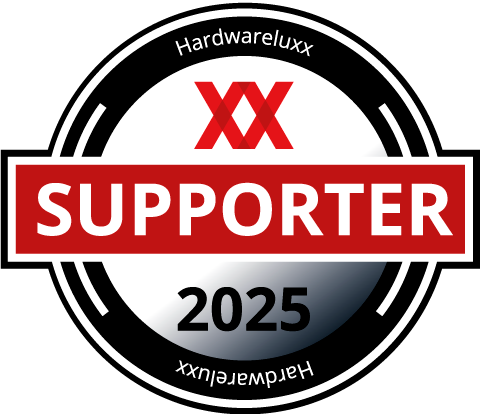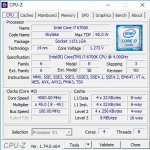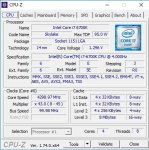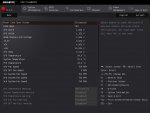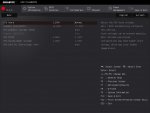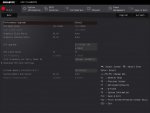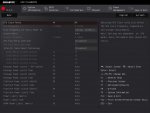

Specifications
Intel® Thunderbolt™ 3 Certified Motherboard
•Supports 6th Generation Intel® Core™ Processor
•Dual Channel DDR4, 4 DIMMs
•Intel® USB 3.1 with USB Type-C™ - The World's Next Universal Connector
•3-Way Graphics Support with Exclusive Ultra Durable Metal Shielding over the PCIe Slots
•Dual PCIe Gen3 x4 M.2 Connectors with up to 32Gb/s Data Transfer (PCIe NVMe & SATA SSD support)
•3 SATA Express Connectors for up to 16Gb/s Data Transfer
•Integrated HDMI 2.0 support
•Creative SoundCore™ 3D Gaming Audio
•Killer™ E2400 and Intel® Gaming Networks
•LED Trace Path with Multi-Color Choice
•APP Center Including EasyTune™ and Cloud Station™ Utilities
•GIGABYTE UEFI DualBIOS™ Technology
CPU
1.Support for Intel® Core™ i7 processors/Intel® Core™ i5 processors/ Intel® Core™ i3 processors/Intel® Pentium® processors/ Intel® Celeron® processors in the LGA1151 package
2.L3 cache varies with CPU
Chipset
1.Intel® Z170 Express Chipset
Memory
1.4 x DDR4 DIMM sockets supporting up to 64 GB of system memory
* Due to a Windows 32-bit operating system limitation, when more than 4 GB of physical memory is installed, the actual memory size displayed will be less than the size of the physical memory installed.
2.Dual channel memory architecture
3.Support for DDR4 3866(O.C)/3733(O.C)/3666(O.C) /3600(O.C.) /3466(O.C.) /3400(O.C.) /3333(O.C.) /3300(O.C.) /3200(O.C.) /3000(O.C.) /2800(O.C.) /2666(O.C.) /2400(O.C.) /2133 MHz memory modules
4.Support for ECC UDIMM 1Rx8/2Rx8 memory modules (operate in non-ECC mode)
5.Support for non-ECC UDIMM 1Rx8/2Rx8/1Rx16 memory modules
6.Support for Extreme Memory Profile (XMP) memory modules
Onboard Graphics
Integrated Graphics Processor-Intel® HD Graphics support: 1.1 x DisplayPort, supporting a maximum resolution of 4096x2304@60 Hz
* Support for DisplayPort 1.2 version.
ŠŠ Integrated Graphics Processor+MegaChips MCDP2800 chip: 1.1 x HDMI 2.0 port
Requires the latest Intel® Graphic Driver from GIGABYTE website.
Maximum shared memory of 512 MB
Audio
1.Creative® Sound Core 3D chip
2.Support for Sound Blaster Recon3Di
3.TI Burr Brown® OPA2134 operational amplifier
4.High Definition Audio
5.2/5.1-channel
6.Support for S/PDIF Out
LAN
1.1 x Intel® GbE LAN chip (10/100/1000 Mbit)(LAN1)
2.1 x Killer E2400 chip (10/100/1000 Mbit) (LAN2)
* Teaming is not supported.
Expansion Slots
1.1 x PCI Express x16 slot, running at x16 (PCIEX16)
* For optimum performance, if only one PCI Express graphics card is to be installed, be sure to install it in the PCIEX16 slot.
2.1 x PCI Express x16 slot, running at x8 (PCIEX8)
* The PCIEX8 slot shares bandwidth with the PCIEX16 slot. When the PCIEX8 slot is populated, the PCIEX16 slot will operate at up to x8 mode.
3.1 x PCI Express x16 slot, running at x4 (PCIEX4)
* The PCIEX4 slot shares bandwidth with the M2H_32G connector. The PCIEX4 slot will become unavailable when an SSD is installed in the M2H_32G connector.
4.3 x PCI Express x1 slots
(All of the PCI Express slots conform to PCI Express 3.0 standard.)
Mlti-Graphics Technology
1.Support for 3-Way/2-Way AMD CrossFire™ and 2-Way NVIDIA® SLI™ Technology
Storage Interface
Chipset: 1.2 x M.2 Socket 3 connectors (Socket 3, M key, type 2242/2260/2280 SATA & PCIe x4/x2/x1 SSD support)
2.3 x SATA Express connectors
3.6 x SATA 6Gb/s connectors (SATA3 0~5)
4.Support for RAID 0, RAID 1, RAID 5, and RAID 10
* Refer to "1-10 Internal Connectors," for the supported configurations with the M.2, SATA Express, and SATA connectors.
ASMedia® ASM1061 chip: 1.2 x SATA 6Gb/s connectors (SATA3 6~7), supporting AHCI mode only
USB
Chipset: 1.5 x USB 3.0/2.0 ports on the back panel
2.4 x USB 2.0/1.1 ports (available through the internal USB headers)
Chipset+Renesas® USB 3.0 Hub: 1.4 x USB 3.0/2.0 ports (available through the internal USB headers)
Chipset+Intel® Thunderbolt™ 3 Controller: 1.1 x USB Type-C™ port on the back panel, with USB 3.1 support
2.1 x USB 3.1 Type-A port (red) on the back panel
Internal I/O Connectors
1.1 x 24-pin ATX main power connector
2.1 x 8-pin ATX 12V power connector
3.2 x M.2 Socket 3 connectors
4.3 x SATA Express connectors
5.8 x SATA 6Gb/s connectors
6.1 x I/O shield audio LED power connector
7.1 x CPU fan header
8.1 x water cooling fan header (CPU_OPT)
9.3 x system fan headers
10.1 x front panel header
11.1 x front panel audio header
12.2 x USB 3.0/2.0 headers
13.2 x USB 2.0/1.1 headers
14.1 x Trusted Platform Module (TPM) header
15.1 x serial port header
16.1 x Clear CMOS jumper
17.1 x power button
18.1 x reset button
19.1 x Clear CMOS button
20.1 x ECO button
21.1 x OC button
22.1 x audio gain control switch
23.Voltage Measurement Points
24.1 x BIOS switch
Back Panel Connectors
1.1 x PS/2 keyboard/mouse port
2.1 x DisplayPort
3.1 x HDMI port
4.1 x USB Type-C™ port, with USB 3.1 support
5.1 x USB 3.1 Type-A port (red)
6.5 x USB 3.0/2.0 ports
7.2 x RJ-45 ports
8.1 x optical S/PDIF Out connector
9.5 x audio jacks (Center/Subwoofer Speaker Out, Rear Speaker Out, Line In/Mic In, Line Out, Headphone)
I/O Controller
1.iTE® I/O Controller Chip
H/W Monitoring
1.System voltage detection
2.CPU/System/Chipset temperature detection
3.CPU/CPU OPT/System fan speed detection
4.CPU/System/Chipset overheating warning
5.CPU/CPU OPT/System fan fail warning
6.CPU/CPU OPT/System fan speed control
* Whether the fan speed control function is supported will depend on the cooler you install.
Bios
1.2 x 128 Mbit flash
2.Use of licensed AMI UEFI BIOS
3.Support for DualBIOS™
4.PnP 1.0a, DMI 2.7, WfM 2.0, SM BIOS 2.7, ACPI 5.0
Unique Features
1.Support for APP Center
* Available applications in APP Center may vary by motherboard model. Supported functions of each application may also vary depending on motherboard specifications.
3D OSD
@BIOS
Ambient LED
AutoGreen
Cloud Station
EasyTune
Easy RAID
Fast Boot
Smart TimeLock
Smart Keyboard
Smart Backup
System Information Viewer
USB Blocker
2.Support for Q-Flash
3.Support for Smart Switch
4.Support for Xpress Install
Bundle Software
1.Norton® Internet Security (OEM version)
2.Intel® Smart Response Technology
Operating System
1.Support for Windows 10/8.1/7*
* Please download “Windows® USB Installation Tool” to install Windows® 7.
Form Factor
1.ATX Form Factor; 30.5cm x 24.4cm
Box Contents
1.GA-Z170X-Gaming 7 motherboard
2.Motherboard driver disk
3.User's Manual
4.Quick Installation Guide
5.Four SATA cables
6.I/O Shield
7.One 2-Way SLI bridge connector
8.One G Connector
9.One pack of back I/O dust covers
Remark
1.Due to different Linux support condition provided by chipset vendors, please download Linux driver from chipset vendors' website or 3rd party website.
2.Most hardware/software vendors may no longer offer drivers to support Win9X/ME/2000/XP. If drivers are available from the vendors, we will update them on the GIGABYTE website
Reviews
GIGABYTE Z170X Gaming 7 Motherboard Review
Gigabyte Z170X-Gaming 7 | TrustedReviews
GIGABYTE GA-Z170X-Gaming 7 - Bjorn3D.com
Gigabyte GA-Z170X-Gaming-7
Gigabyte GA-Z170X-Gaming 7 Motherboard Review
OVP/Zubehör/Layout/Features




Geizhals Link
https://geizhals.de/gigabyte-ga-z170x-gaming-7-a1306472.html
Treiber&Tools
GIGABYTE - Motherboard - Socket 1151 - GA-Z170X-Gaming 7 (rev. 1.0)
Bios Downloadlink
GIGABYTE - Motherboard - Socket 1151 - GA-Z170X-Gaming 7 (rev. 1.0)
Bios History
F5
1.Update CPU Microcode
F5p
1.Beta BIOS
2.Improve DDR XMP compatibility
F4
1.Fix Intel processor issue which may cause some video games to exhibit launch issues with video game error code 8016.
F3
1.Update CPU Microcode
F2
1.First Release
Beta Bios
Aktuelle Beta Biose findet ihr wie immer bei JZ auf seiner Homepage im Drop Down Menü
Das Flashen geschieht wie immer auf eigene Gefahr.
http://www.jzelectronic.de/jz2/index.php
CPU Support Liste
GIGABYTE TECHNOLOGY Socket 1151 - Intel Z170 - GA-Z170X-Gaming 7 (rev. 1.0)
Zuletzt bearbeitet:

